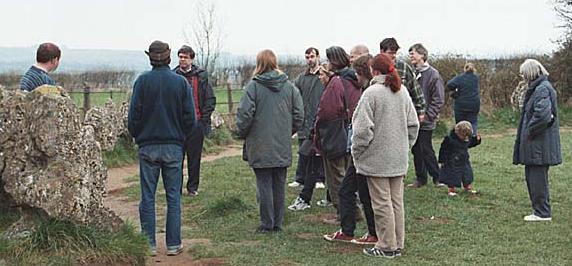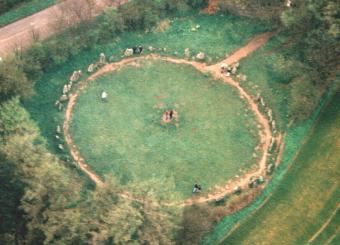Free preview of our Stone
Circles CD-ROM in the new Stone Circle Shop
Megalithic Mysteries - England Navigation:
In 1997 the regulars of the Stones Mailing List and their friends gathered at the Rollright Stones for a get-together, the first of many as it turned out. We were treated to a talk by George Lambrick, leader of the only recent excavation of the Rollright Stones and a trustee of the Rollright Stones Charitable Trust. At the time he was Deputy Director of the Oxford Archaeology Unit. He has since
![]() All these clips use RealAudio, using the free player
available for most systems. They should also play if you have a recent version of the
Microsoft Media Player so try clicking on a track. Why not start one playing and go off
and explore...
All these clips use RealAudio, using the free player
available for most systems. They should also play if you have a recent version of the
Microsoft Media Player so try clicking on a track. Why not start one playing and go off
and explore...
![]() Download
the FREE Real Player from www.real.com
Download
the FREE Real Player from www.real.com
| All at once | The whole talk. See below for contents and transcripts (thanks Martin)... |
Play now |

| 1 | Introduction, description of The
Whispering Knights Portal Dolmen George Lambrick: There are three groups of stones. The stone circle is, perhaps, the best known. And then there's the Whispering Knights which is a...you can just see through the trees in the next field...which is a neolithic burial chanber; and the King's Stone which is a single stone standing across the road. They are [of] widely differing dates. And the Whispering Knights is probably the earliest of these monuments. By analogy and by some pottery that we discovered in the 1980s it appears to be Early Neolithic---say, around 3500 or 4000 BC. The Whispering Knights is a kind of neolithic timb called a "portal dolmen" and these are mostly found in Cornwall, Ireland and Wales. And this is the easternmost example that we know of in Britain and it would probably have contained disarticulated burials. The only evidence of burials was a human jawbone found in the 1920s. |
Play now |
| Save for later |
| 2 | More about the King's Men Stone
Circle, Norman Lockyer, Circle Design The stone circle is probably later Neolithic; perhaps something like 1000 or even 1500 years later. It has some interesting characteristics. It was scheduled as an ancient monument in 1882, along with the other stones, and that was because people were chipping bits off---which was particularly relevent with the King's Stone. One of the problems with interpreting it is that in 1882 some of the stones were re-errected. Now one of the things that we discovered was that by looking through all the antiquarian drawings of the stone circle---going back to the 17th century---it's possible to work out which stones are still standing as they were then an which ones have been moved. And, in fact, one of the drawings, we discovered, was by Sir Norman Lockyer who was the Astronomer Royal in the late 19th century and who had drawn a plan of the circle in, I think it was, 1860 and then had come back and made more annotations in 1872; and then had come back again in 1890 and had discovered that a whole lot of stones had been moved around. [*Someone chuckles*] Anyway, the upshot of that was to see whether we could work out what the design of the stone circle was and what kind of circle it was related to other ones. And basically what we discovered was that a lot of the stones in their original positions are standing very close to each other. And the best group is over there. If you take the tallest stone; then there's a small stone; and that rather pointed one; and a sort of trapezoidal one. Then there's a very big flat one; two smaller ones; and another rather pointed one. By looking at the antiquarian drawings you can see that the tallest one was standing; the next one was fallen inwards; the next one was standing; the little one was fallen inwards; and then the next four were all standing. And you can see how very close those are together. You can also see, when you look at that group, that those six which were standing have large white lichens on them, and the others don't. And we did a survey of all the lichens on the stones and that helped to confirm which ones are in their original position. The conclusion from all that was that originally the stone circle was more or less a continuous wall of stones. |
Play now |
| Save for later |

| 3 | Theories about the King's Stone,
Possible Long Barrow, Round Cairn, Bronze Age Cremations We did some work around the King Stone, and one of the numerous theories about the King Stone was that it was part of a long barrow, which was the long mound behind it. Which of course was the mound which rose up in front of the King and stopped his view of Long Compton. OGS Crawford, who was the first Ordnance Survey archaeologist, had claimed that the notch out of it might be one half of what's called a porthole entrance to the long cairn. But in fact the notch is quite clearly the result of people chipping bits off in the 19th century. Anyway, we put a trench across that mound to see whether it was natural or whatever, and discovered a round cairn by the King Stone - previously undiscovered, which was still intact - so it was about 17 metres across, and had various cremations put in it, and a little cremation next to it, which had been marked. And there's also a very small barrow next to it, which we also excavated, and again found cremations - one of which was buried in a funny little cavern under the ground which had a big, broad post erected next to it. So in both cases there was evidence that these were Bronze Age burials, marked by standing wooden posts, and so the theory which I like best about the King Stone is that it was erected as a memorial to a burial ground. |
Play now |
| Save for later |
| 4 | Other Sites: Ring Ditches, second
Portal Dolmen, Iron Age Enclosure, Roman Burial Site, Saxon Cemetary The other thing is that there are quite a number of other sites around the complex. There are two Bronze Age ring ditches in the field down that way; there's the site of possibly another tomb like the Whispering Knights---which we looked for and which there's no trace of---it was being destroyed in the 19th century. There's an Iron Age enclosure with a trackway leading to it which goes from past the Whispering Knights---sometimes misinterpreted as a cursus monument but actually... {Andy Norfolk: Yes, that'll be the one that was on the aerial photo that Paul Devereux was so excited about.} Yes. It's actually Late Bronze Age or Early Iron Age. And there's another ring ditch by the King's Stone; a Roman settlement site; and a Saxon cemetary round the junction of the three parish boundaries between Little Rollright, Great Rollright and Long Compton which was discovered in 19th century quarrying and never been investigated since. So there's quite a long history of activity. |
Play now |
| Save for later |
Credits:
Speaker: George Lambrick
Get-together arranged by: Chris Tweed
Talks, Lunch, everything else on the day: Karin Attwood
Questions & Heckling :-): John Attwood, Andy Norfolk, Squonk, David Craig & anyone
else I've forgotten
Mini-Disc recorder: Trevor Brook
Sound Engineer, Editing & Web Presentation: Andy Burnham
Transcript: Martin McCarthy
Photography: Chris Tweed, Andy Burnham
Music improvised by: Alastair McIvor and recorded on location inside West Kennett Long
Barrow
Video Recorder beeps :-) Bobbie
Patience: Ruth
Squeaks: Chloe
| MEGALITHIC MYSTERIES | MEGALITHS IN ENGLAND | MEGALITHS IN SCOTLAND | INDEX |